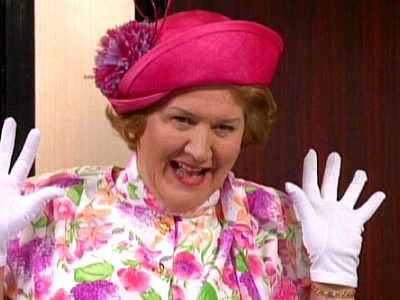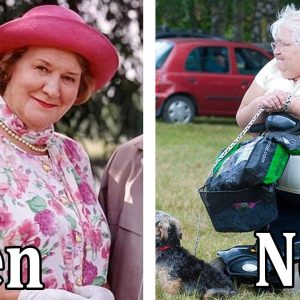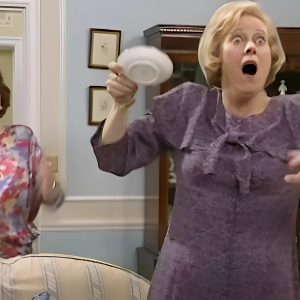“Keeping Up Appearances”: How a Rubber-Gloved Matriarch Became a Global Phenomenon
In the realm of classic British sitcoms, few characters have left a mark as indelible—and hilariously formidable—as Hyacinth Bucket (pronounced Bouquet, of course). Brought vividly to life by Dame Patricia Routledge, the ambitious, etiquette-obsessed matron of Keeping Up Appearances has not only won over British audiences since her debut in 1990 but has also conquered international airwaves, becoming the BBC’s most exported television show of all time.
Now, with a highly anticipated prequel series titled Young Hyacinth on the horizon, interest in the original series is surging anew, and the story behind its creation and legacy is every bit as compelling as the on-screen antics that made it a global sensation.
A Universal Truth Beneath the Teacups
“Namely, they all know one,” mused Roy Clarke, the genius behind Keeping Up Appearances, as he reflected on the series’ lasting appeal across cultural boundaries. “However seriously different cultures may be, there is, under the surface, a common factor – human beings.”
It’s this essential truth that Clarke tapped into when crafting the character of Hyacinth Bucket—a woman whose obsessive drive for social status, manners, and refinement resonates universally, even as it is cloaked in the uniquely British trappings of bone china and church socials. Hyacinth, after all, is not just a character; she is an archetype. We’ve all encountered—or perhaps even lived with—a Hyacinth.
From Yorkshire Observations to Global Stardom
For Clarke, Hyacinth was never a figment of pure imagination. In fact, she was perhaps the most real of all his characters.
“Hyacinth Bucket was the least invented of all the characters I’ve found in my head over the years,” he admitted in a reflective piece for the Daily Mirror. “I took her largely from life.”
Raised in Yorkshire, Clarke had a keen eye for observing the minutiae of social dynamics. His career would see him pen multiple long-running, beloved comedies—Last of the Summer Wine and Open All Hours among them—but it was with Keeping Up Appearances that he created a character so authentic, so vividly drawn, that she leapt off the screen and into pop culture legend.
“Fearsome females are ruling their households with a firm hand in a rubber glove,” Clarke quipped, capturing the essence of Hyacinth’s domineering yet comically deluded approach to life. Whether terrorizing her neighbors with unexpected candlelit suppers or admonishing her long-suffering husband Richard (played by Clive Swift), Hyacinth reigned supreme with a cocktail of misplaced confidence and impeccable elocution.
The Power of Patricia Routledge
Of course, no discussion of Keeping Up Appearances can overlook the extraordinary performance of Dame Patricia Routledge. With precision comic timing and theatrical gravitas, Routledge elevated Hyacinth beyond mere caricature. She infused the character with pathos and vulnerability, allowing audiences to laugh at her pretensions while occasionally feeling a twinge of sympathy for her misguided aspirations.

The role became synonymous with Routledge, cementing her status as a national treasure. Yet, despite calls for revivals and sequels, Routledge has remained firm in her decision not to return to the character, preferring to let Hyacinth’s legacy remain untouched.
Her absence will be felt in the upcoming prequel, Young Hyacinth, but the BBC is betting that audiences’ fascination with the character’s origin story will outweigh their nostalgia for the original casting.
A New Chapter: Young Hyacinth
Set in the 1950s, Young Hyacinth explores the formative years of the aspiring socialite. At 19, Hyacinth is already cultivating her distinctive obsession with class and propriety, though she’s still firmly rooted in a working-class family that provides ample obstacles to her upwardly mobile dreams.
The prequel promises to peel back the layers of Hyacinth’s polished exterior to reveal the forces—familial, societal, and personal—that forged the woman we came to know decades later. From dealing with her slapdash sisters to navigating early romantic misadventures, young Hyacinth’s world is every bit as chaotic, with perhaps even higher emotional stakes.
The casting of a new actress to embody Hyacinth’s youthful zeal is still under wraps, but early reports suggest a sharp script and nostalgic production design aimed at capturing the charm and humor that made the original series so beloved.
Global Appeal: From Coventry to the Commonwealth
What is perhaps most astounding is the sheer international reach of Keeping Up Appearances. The show has been purchased more than 1,000 times in territories as far-flung as Nigeria, Australia, and Canada. It even beat out Top Gear, long thought to be the BBC’s most successful export.
Why does Hyacinth translate so well across borders?
Because, as Roy Clarke insightfully noted, “Everyone knows one.” Whether in a bustling African city, a quiet Australian suburb, or a New York brownstone, there is a universal recognition of the Hyacinths of the world—those who aspire to be something they are not, who cling to decorum in a world that resists it, and who, in their quest for perfection, often sow delightful chaos.
The Enduring Legacy of a Rubber-Gloved Matriarch
In the end, Keeping Up Appearances endures not because of slapstick or spectacle, but because it strikes a chord. Beneath Hyacinth’s comically exaggerated mannerisms lies a very human desire: to be seen, to be respected, to matter. That desire, wrapped in Royal Doulton china and smothered in social anxiety, is both timeless and borderless.
As Young Hyacinth prepares to introduce a new generation to the origins of television’s most iconic snob, audiences around the world may once again find themselves laughing, cringing, and—just perhaps—relating more than they care to admit.
Because no matter where you’re from, you’ve probably had tea with a Hyacinth Bucket. You just didn’t dare pronounce it wrong.
Stay tuned for more updates on Young Hyacinth and other BBC classics making their return. For now, we raise our teacups to the Queen of Social Climbing—Hyacinth Bouquet.




